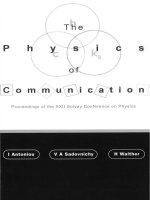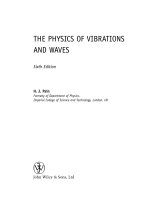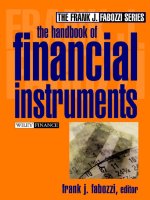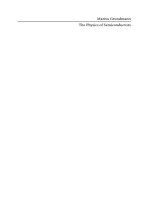Fletcher rossing the physics of musical instruments
Bạn đang xem bản rút gọn của tài liệu. Xem và tải ngay bản đầy đủ của tài liệu tại đây (22.67 MB, 764 trang )
www.SolutionManual.info
The Physics of Musical Instruments
Second Edition
Neville H. Fletcher
Thomas D. Rossing
The Physics of
Musical Instruments
Second Edition
With 485 Illustrations
www.SolutionManual.info
~Springer
Thomas D. Rossing
Department of Physics
Northern Illinois University
DeKalb, IL 60115
USA
Neville H. Fletcher
Research School of Physical
Sciences and Engineering
Australian National University
Canberra, A.C.T. 0200
Australia
Cover illustration: French hom. © The Viesti Collection, Inc.
Library of Congress Cataloging-in-Publication Data
Fletcher, Neville H. (Neville Homer)
The physics of musical instruments I Neville H. Fletcher : Thomas
D. Rossing. - 2nd ed.
p. em.
Includes bibliographical references (p. ) and index.
ISBN 978-0-387-21603-4 (eBook)
ISBN 978-1-4419-3120-7
DOI 10.1007/978-0-387-21603-4
1. Music - Acoustics and physics. 2. Musical instruments Construction. I. Rossing, Thomas D., 1929- II. Title.
ML3805.F58 1998
97-35360
784.19'01'53-dc21
ISBN 978-1-4419-3120-7
Printed on acid-free paper.
© 1998 Springer Science+Business Media New York
Originally published by Springer Science+Business Media, Inc. in 1998
Softcover reprint of the hardcover 2nd edition 1998
All rights reserved. This work may not be translated or copied in whole or in part without the written permission of the publisher Springer Science+Business Media, LLC,
except for brief excerpts in connection with reviews or scholarly analysis.
Use in connection with any form of information storage and retrieval, electronic adaptation, computer software, or by similar or dissimilar methodology now known or hereafter developed is forbidden.
The use in this publication of trade names, trademarks, service marks, and similar terms, even if
they are not identified as such, is not to be taken as an expression of opinion as to whether or not
they are subject to proprietary rights.
9 8 7 6 5
Corrected 5th printing, 2005.
springeronline.com
SPIN 11340768
Preface
When we wrote the first edition of this book, we directed our presentation to the reader with a compelling interest in musical instruments who
has "a reasonable grasp of physics and who is not frightened by a little
mathematics." We are delighted to find how many such people there are.
The opportunity afforded by the preparation of this second edition has
allowed us to bring our discussion up to date by including those new insights
that have arisen from the work of many dedicated researchers over the past
decade. We have also taken the opportunity to revise our presentation of
some aspects of the subject to make it more general and, we hope, more
immediately accessible. We have, of course, corrected any errors that have
come to our attention, and we express our thanks to those friends who
pointed out such defects in the early printings of the first edition.
We hope that this book will continue to serve as a guide, both to those
undertaking research in the field and to those who simply have a deep
interest in the subject.
www.SolutionManual.info
June 1991
N.H.F and T.D.R.
v
Preface to the First Edition
The history of musical instruments is nearly as old as the history of civilization itself, and the aesthetic principles upon which judgments of musical
quality are based are intimately connected with the whole culture within
which the instruments have evolved. An educated modern Western player
or listener can make critical judgments about particular instruments or
particular performances but, to be valid, those judgments must be made
within the appropriate cultural context.
The compass of our book is much less sweeping than the first paragraph
might imply, and indeed our discussion is primarily confined to Western
musical instruments in current use, but even here we must take account
of centuries of tradition. A musical instrument is designed and built for
the playing of music of a particular type and, conversely, music is written
to be performed on particular instruments. There is no such thing as an
"ideal" instrument, even in concept, and indeed the unbounded possibilities
of modern digital sound-synthesis really require the composer or performer
to define a whole set of instruments if the result is to have any musical
coherence. Thus, for example, the sound and response of a violin are judged
against a mental image of a perfect violin built up from experience of violins
playing music written for them over the centuries. A new instrument may
be richer in sound quality and superior in responsiveness, but if it does not
fit that image, then it is not a better violin.
This set of mental criteria has developed, through the interaction of musical instruments makers, performers, composers, and listeners, over several
centuries for most musical instruments now in use. The very features of
particular instruments that might be considered as acoustic defects have
become their subtle distinguishing characteristics, and technical "improvements" that have not preserved those features have not survived. There
are, of course, cases in which revolutionary new features have prevailed
over tradition, but these have resulted in almost new instrument typesthe violin and cello in place of the viols, the Boehm flute in place of its
baroque ancestor, and the saxophone in place of the taragato. Fortunately,
perhaps, such profound changes are rare, and most instruments of today
vii
viii
Preface to the First Edition
have evolved quite slowly, with minor tonal or technical improvements reflecting the gradually changing mental image of the ideal instrument of
that type.
The role of acoustical science in this context is an interesting one. Centuries of tradition have developed great skill and understanding among the
makers of musical instruments, and they are often aware of subtleties that
are undetected by modern acoustical instrumentation for lack of precise
technical criteria for their recognition. It is difficult, therefore, for a scientist to point the way forward unless the problem or the opportunity has
been identified adequately by the performer or the maker. Only rarely do
all these skills come together in a single person.
The first and major role of acoustics is therefore to try to understand all
the details of sound production by traditional instruments. This is a really
major program, and indeed it is only within the past few decades that we
have achieved even a reasonable understanding of the basic mechanisms
determining tone quality in most instruments. In some cases even major
features of the sounding mechanism itself have only recently been unravelled. This is an intellectual exercise of great fascination, and most of our
book is devoted to it. Our understanding of a particular area will be reasonably complete only when we know the physical causes of the differences
between a fine instrument and one judged to be of mediocre quality. Only
then may we hope that science can come to the help of music in moving the
design or performance of contemporary instruments closer to the present
ideal.
This book is a record of the work of very many people who have studied
the physics of musical instruments. Most of them, following a long tradition, have done so as a labor of love, in time snatched from scientific or
technical work in a field of more immediate practical importance. The community of those involved is a world-wide and friendly one in which ideas
are freely exchanged, so that, while we have tried to give credit to the originators wherever possible, there will undoubtedly be errors of oversight. For
these we apologize. We have also had to be selective, and many interesting
topics have perforce been omitted. Again the choice is ours, and has been
influenced by our own particular interests, though we have tried to give a
reasonably balanced treatment of the whole field.
The reader we had in mind in compiling this volume is one with a reasonable grasp of physics and who is not frightened by a little mathematics.
There are fine books in plenty about the history of particular musical instruments, lavishly illustrated with photographs and drawings, but there
is virtually nothing outside the scientific journal literature that attempts
to come to grips with the subject on a quantitative basis. We hope that we
have remedied that lack. We have not avoided mathematics where precision
is necessary or where hand-waving arguments are inadequate, but at the
same time we have not pursued formalism for its own sake. Detailed phys-
www.SolutionManual.info
Preface to the First Edition
ix
ical explanation has always been our major objective. We hope that the
like-minded reader will enjoy coming to grips with this fascinating subject.
The authors owe a debt of gratitude to many colleagues who have contributed to this book. Special thanks are due to Joanna Daly and Barbara
Sullivan, who typed much of the manuscript and especially to Virginia Plemons, who typed most of the final draft and prepared a substantial part of
the artwork. Several colleagues assisted in the proofreading, including Rod
Korte, Krista McDonald, David Brown, George Jelatis, and Brian Finn.
We are grateful to David Peterson, Ted Mansell, and other careful readers
who alerted us to errors in the first printing. Thanks are due to our many
colleagues for allowing us to reprint figures and data from their publications, and to the musical instrument manufacturers that supplied us with
photographs. Most of all, we thank our colleagues in the musical acoustics
community for many valuable discussions through the years that led to our
writing this book.
December 1988
Neville H. Fletcher
Thomas D. Rossing
Contents
Preface
v
Preface to the First Edition
vii
I. Vibrating Systems
1. Free and Forced Vibrations of Simple Systems
1.1. Simple Harmonic Motion in One Dimension
1.2. Complex Amplitudes
1.3. Superposition of Two Harmonic Motions in One
Dimension
1.4. Energy
1.5. Damped Oscillations
1.6. Other Simple Vibrating Systems
1.7. Forced Oscillations
1.8. Transient Response of an Oscillator
1.9. Two-Dimensional Harmonic Oscillator
1.10. Graphical Representations of Vibrations:
Lissajous Figures
1.11. Normal Modes of Two-Mass Systems
1.12. Nonlinearity
Appendix
References
www.SolutionManual.info
2. Continuous Systems in One Dimension:
Strings and Bars
2.1.
2.2.
2.3.
2.4.
2.5.
Linear Array of Oscillators
Transverse Wave Equation for a String
General Solution of the Wave Equation: Traveling Waves
Reflection at Fixed and Free Ends
Simple Harmonic Solutions to the Wave Equation
3
4
6
7
10
11
13
18
21
23
25
26
28
29
32
34
34
36
37
38
39
xi
xii
Contents
Standing Waves
Energy of a Vibrating String
Plucked String: Time and Frequency Analyses
Struck String
Bowed String
Driven String: Impedance
Motion of the End Supports
Damping
Longitudinal Vibrations of a String or Thin Bar
Bending Waves in a Bar
Bars with Fixed and Free Ends
Vibrations of Thick Bars: Rotary Inertia and
Shear Deformation
2.18. Vibrations of a Stiff String
2.19. Dispersion in Stiff and Loaded Strings: Cutoff Frequency
2.20. Torsional Vibrations of a Bar
References
2.6.
2.7.
2.8.
2.9.
2.10.
2.11.
2.12.
2.13.
2.14.
2.15.
2.16.
2.17.
3. Two-Dimensional Systems: Membranes, Plates,
and Shells
3.1. Wave Equation for a Rectangular Membrane
3.2. Square Membranes: Degeneracy
3.3. Circular Membranes
3.4. Real Membranes: Stiffness and Air Loading
3.5. Waves in a Thin Plate
3.6. Circular Plates
3. 7. Elliptical Plates
3.8. Rectangular Plates
3.9. Square Plates
3.10. Square and Rectangular Plates with Clamped Edges
3.11. Rectangular Wood Plates
3.12. Bending Stiffness in a Membrane
3.13. Vibration of Shells
3.14. Driving Point Impedance
References
4. Coupled Vibrating Systems
4.1.
4.2.
4.3.
4.4.
4.5.
4.6.
4.7.
Coupling Between Two Identical Vibrators
Normal Modes
Weak and Strong Coupling
Forced Vibrations
Coupled Electrical Circuits
Forced Vibration of a Two-Mass System
Systems with Many Masses
39
40
40
44
46
50
52
53
56
58
60
63
64
65
66
68
70
70
72
73
75
76
78
80
80
83
85
88
91
92
96
99
102
102
103
105
107
111
115
116
Contents
4.8. Graphical Representation of Frequency Response
Functions
4.9. Vibrating String Coupled to a Soundboard
4.10. Two Strings Coupled by a Bridge
APPENDIX
References
5. Nonlinear Systems
5.1. A General Method of Solution
5.2. The Nonlinear Oscillator
5.3. The Self-Excited Oscillator
5.4. Multimode Systems
5.5. Mode Locking in Self-Excited Systems
5.6. Nonlinear Effects in Strings
5. 7. Nonlinear Effects in Plates and Shells
References
xiii
117
119
120
125
131
133
134
136
139
140
143
144
148
150
II. Sound Waves
6. Sound Waves in Air
6.1. Plane Waves
6.2. Spherical Waves
6.3. Sound Pressure Level and Intensity
6.4. Reflection, Diffraction, and Absorption
6.5. Normal Modes in Cavities
References
www.SolutionManual.info
7. Sound Radiation
7.1. Simple Multipole Sources
7.2. Pairs of Point Sources
7.3. Arrays of Point Sources
7.4. Radiation from a Spherical Source
7.5. Line Sources
7.6. Radiation from a Plane Source in a Baffle
7.7. Unbaffied Radiators
7.8. Radiation from Large Plates
References
155
156
160
161
163
167
169
171
171
174
176
179
181
181
185
186
189
8. Pipes, Horns and Cavities
190
Infinite Cylindrical Pipes
Wall Losses
Finite Cylindrical Pipes
Radiation from a Pipe
190
193
196
201
8.1.
8.2.
8.3.
8.4.
xiv
Contents
8.5. Impedance Curves
8.6. Horns
8.7. Finite Conical Horns
8.8. Bessel Horns
8.9. Compound Horns
8.10. Perturbations
8.11. Numerical Calculations
8.12. Curved Horns
8.13. Measurement of Acoustic Impedance
8.14. The Time Domain
8.15. Network Analogs
References
202
205
210
213
216
218
220
220
222
223
227
232
III. String Instruments
9. Guitars and Lutes
9.1.
9.2.
9.3.
9.4.
9.5.
Design and Construction of Guitars
The Guitar as a System of Coupled Vibrators
Force Exerted by the String
Modes of Vibration of Component Parts
Coupling of the Top Plate to the Air Cavity:
Two-Oscillator Model
9.6. Coupling to the Back Plate: Three-Oscillator Model
9.7. Resonances of a Guitar Body
9.8. Response to String Forces
9.9. Sound Radiation
9.10. Resonances, Radiated Sound, and Quality
9.11. A Family of Scaled Guitars
9.12. Use of Synthetic Materials
9.13. Electric Guitars
9.14. Frets and Compensation
9.15. Lutes
9.16. Other Plucked String Instruments
9.17. One-Sided Bridge Constraints
References
10. Bowed String Instruments
10.1.
10.2.
10.3.
10.4.
10.5.
10.6.
10.7.
A Brief History
Research on Violin Acoustics
Construction of the Violin
Motion of Bowed Strings
Violin Body Vibrations
Transient Wave Response of the Violin Body
Soundpost and Bass Bar
239
239
240
241
245
248
250
251
253
256
258
260
261
262
263
264
265
268
269
272
272
273
274
275
285
294
295
Contents
10.8. The Bridge
10.9. Sound Radiation
10.10. The Bow
10.11. Wolf Notes and Playability
10.12. Tonal Quality of Violins
10.13. Viola, Cello, and Double Bass
10.14. Viols
10.15. A New Violin Family
References
11. Harps, Harpsichords, Clavichords, and Dulcimers
11.1. Traditional Instruments
11.2. The Harp
11.3. The Harpsichord
11.4. Harpsichord Design Considerations
11.5. Harpsichord Characteristics
11.6. The Clavichord
References
12. The Piano
General Design of Pianos
Piano Action
Piano Strings
Piano Hammers
The Soundboard
Sound Decay: Interaction of Strings, Bridge,
and Soundboard
12. 7. Scaling and Tuning
12.8. Tuning and Inharmonicity
12.9. Timbre
12.10. Electric Pianos
References
12.1.
12.2.
12.3.
12.4.
12.5.
12.6.
www.SolutionManual.info
xv
297
301
310
312
313
318
319
322
326
331
331
336
340
343
346
347
350
352
353
354
362
366
374
383
387
388
390
396
396
IV. Wind Instruments
13. Sound Generation by Reed and Lip Vibrations
401
Pressure-Controlled Valves
Quasi-Static Model
Generator Behavior at Playing Frequency
Free Reeds
Generators Coupled to Horns
Large-Amplitude Behavior
Nonlinear Analysis
401
403
406
413
415
418
422
13.1.
13.2.
13.3.
13.4.
13.5.
13.6.
13.7.
xvi
Contents
13.8. Numerical Simulation
References
14. Lip-Driven Brass Instruments
14.1. Historical Development of Brass Instruments
14.2. Horn Profiles
14.3. Mouthpieces
14.4. Radiation
14.5. Slides and Valves
14.6. Small-Amplitude Nonlinearity
14. 7. Large-Amplitude Nonlinearity
14.8. Input Impedance Curves
14.9. Transients
14.10. Acoustic Spectra
14.11. Mutes
14.12. Performance Technique
References
15. Woodwind Reed Instruments
15.1. Woodwind Bore Shapes
15.2. Finger Holes
15.3. Impedance Curves
15.4. Reed and Air Column Interaction
15.5. Directionality
15.6. Performance Technique
15.7. Acoustic Efficiency
15.8. The Limiting Spectrum
15.9. The Clarinet
15.10. The Oboe
15.11. The Bassoon
15.12. The Saxophone
15.13. Capped Reed Instruments
References
16. Flutes and Flue Organ Pipes
16.1.
16.2.
16.3.
16.4.
16.5.
16.6.
16.7.
16.8.
Dynamics of an Air Jet
Disturbance of an Air Jet
Jet-Resonator Interaction
The Regenerative Excitation Mechanism
Rigorous Fluid-Dynamics Approaches
Nonlinearity and Harmonic Generation
Transients and Mode Transitions
Aerodynamic Noise
424
426
429
429
431
433
437
440
442
445
449
450
453
453
455
459
461
461
464
470
477
480
481
484
484
486
491
494
496
497
500
503
503
509
511
516
521
522
525
528
Contents
16.9. Simple Flute-Type Instruments
16.10. The Recorder
16.11. The Flute
References
17. Pipe Organs
17.1. General Design Principles
17.2. Organ Pipe Ranks
17.3. Flue Pipe Ranks
17.4. Characteristic Flue Pipes
17.5. Mixtures and Mutations
17.6. Tuning and Temperament
17.7. Sound Radiation from Flue Pipes
17.8. Transients in Flue Pipes
17.9. Flue Pipe Voicing
17.10. Effect of Pipe Material
17.11. Reed Pipe Ranks
17.12. Analysis of Timbre
17.13. Tonal Architecture
References
xvii
529
531
537
548
552
553
557
559
563
564
566
568
569
570
571
573
575
577
578
www.SolutionManual.info
V. Percussion Instruments
18. Drums
18.1. Kettledrums
18.2. Bass Drums
18.3. Snare Drums
18.4. Tom-Toms
18.5. Indian Drums
18.6. Japanese Drums
18.7. Indonesian Drums
18.8. Latin American Drums
18.9. Tambourines
References
19. Mallet Percussion Instruments
19.1.
19.2.
19.3.
19.4.
19.5.
Glockenspiel
The Marimba
Tuning the Bars
Resonators
The Xylophone
583
584
599
602
606
609
615
618
618
620
621
623
623
624
627
633
636
xviii
Contents
19.6. Vibes
19.7. Mallets
19.8. Chimes
19.9. Triangles and Pentangles
19.10. Gamelan Instruments
19.11. Tubaphones and Gamelan Chimes
References
20. Cymbals, Gongs, Plates, and Steel Drums
20.1. Cymbals
20.2. Tam-Tams
20.3. Gongs
20.4. Crotales
20.5. Bell Plates
20.6. Flexed Plates: The Musical Saw
20.7. Steel Pans
References
21. Bells
21.1. Modes of Vibration of Church Bells
21.2. Tuning and Temperament
21.3. The Strike Note
21.4. Major-Third Bells
21.5. Sound Decay and Warble
21.6. Scaling of Bells
21.7. Modes of Vibration of Handbells
21.8. Timbre and Tuning of Handbells
21.9. Sound Decay and Warble in Handbells
21.10. Scaling of Handbells
21.11. Sound Radiation
21.12. Bass Handbells
21.13. Clappers
21.14. Ancient Chinese Two-Tone Bells
21.15. Temple Bells of China, Korea, and Japan
References
638
639
641
642
645
645
647
649
649
656
660
663
665
665
667
673
675
676
681
682
685
686
688
691
694
695
696
697
699
699
700
701
705
Part VI. Materials
22. Materials for Musical Instruments
711
22.1. Mechanical Properties of Materials
22.2. Materials for Wind Instruments
22.3. Wood
712
717
719
Contents
22.4. Plastics and Composite Materials
22.5. Metals
22.6. Conclusion
References
xix
726
728
732
733
N arne Index
735
Subject Index
743
www.SolutionManual.info
Part I
Vibrating Systems
1
Free and Forced Vibrations of
Simple Systems
Mechanical, acoustical, or electrical vibrations are the sources of sound
in musical instruments. Some familiar examples are the vibrations of
strings (violin, guitar, piano, etc.), bars or rods (xylophone, glockenspiel,
chimes, clarinet reed), membranes (drums, banjo), plates or shells (cymbal,
gong, bell), air in a tube (organ pipe, brass and woodwind instruments,
marimba resonator), and air in an enclosed container (drum, violin, or
guitar body).
In most instruments, sound production depends upon the collective
behavior of several vibrators, which may be weakly or strongly coupled
together. This coupling, along with nonlinear feedback, may cause the instrument as a whole to behave as a complex vibrating system, even though
the individual elements are relatively simple vibrators.
In the first eight chapters, we will discuss the physics of mechanical
and acoustical oscillators, the way in which they may be coupled together,
and the way in which they radiate sound. Since we are not discussing
electronic musical instruments, we will not deal with electrical oscillators
except as they help us, by analogy, to understand mechanical and acoustical
oscillators.
Many objects are capable of vibrating or oscillating. Mechanical vibrations require that the object possess two basic properties: a stiffness or
springlike quality to provide a restoring force when displaced and inertia,
which causes the resulting motion to overshoot the equilibrium position.
From an energy standpoint, oscillators have a means for storing potential energy (spring), a means for storing kinetic energy (mass), and a
means by which energy is gradually lost (damper). Vibratory motion involves the alternating transfer of energy between its kinetic and potential
forms.
The inertial mass may be either concentrated in one location or distributed throughout the vibrating object. If it is distributed, it is usually
the mass per unit length, area, or volume that is important. Vibrations in
distributed mass systems may be viewed as standing waves.
www.SolutionManual.info
3
4
1. Free and Forced Vibrations of Simple Systems
The restoring forces depend upon the elasticity or the compressibility
of some material. Most vibrating bodies obey Hooke's law; that is, the
restoring force is proportional to the displacement from equilibrium, at
least for small displacement.
1.1 Simple Harmonic Motion in One Dimension
The simplest kind of periodic motion is that experienced by a point mass
moving along a straight line with an acceleration directed toward a fixed
point and proportional to the distance from that point. This is called simple
harmonic motion, and it can be described by a sinusoidal function of time
t : x( t) = A sin 211" ft, where the amplitude A describes the maximum
extent of the motion, and the frequency f tells us how often it repeats.
The period of the motion is given by
(1.1)
That is, each T seconds the motion repeats itself.
A simple example of a system that vibrates with simple harmonic motion
is the mass-spring system shown in Fig. 1.1. We assume that the amount
of stretch x is proportional to the restoring force F (which is true in most
springs if they are not stretched too far), and that the mass slides freely
without loss of energy. The equation of motion is easily obtained by combining Hooke's law, F = -Kx, with Newton's second law, F = ma = mx.
Thus,
mx
= -Kx
and
mx+Kx = 0,
where
X
FIGURE 1.1. Simple mass-spring vibrating system.
5
1.1. Simple Harmonic Motion in One Dimension
The constant K is called the spring constant or stiffness of the spring
so
(expressed in newtons per meter). We define a constant wo =
that the equation of motion becomes
JK!iii,
..
2
X+ WoX
= 0.
(1.2)
This well-known equation has these solutions:
+ ¢)
(1.3)
+ C sinwot,
(1.4)
x =A cos(wot
or
x = B coswot
from which we recognize wo as the natural angular frequency of the system.
The natural frequency fo of our simple oscillator is given by the relation
2 + C 2 ; ¢is the initial
fo = (1/2rr)JK!iii, and the amplitude by A=
phase of the motion. Differentiation of the displacement x with respect to
time gives corresponding expressions for the velocity v and acceleration a:
vB
v
= x = -woAsin(wot + ¢),
(1.5)
and
a = x = -w6A cos(wot + ¢ ).
www.SolutionManual.info
(1.6)
The displacement, velocity, and acceleration are shown in Fig. 1.2. Note
that the velocity v leads the displacement by rr /2 radians (90°), and the
acceleration leads (or lags) by rr radians (180°).
Solutions to second-order differential equations have two arbitrary constants. In Eq. (1.3) they are A and ¢; in Eq. (1.4) they are B and C.
Another alternative is to describe the motion in terms of constants x 0 and
vo, the displacement and velocity when t = 0. Setting t = 0 in Eq. (1.3)
gives Xo = A cos¢, and setting t = 0 in Eq. (1.5) gives v 0 = -w0 A sin¢.
l
A
=0
I
FIGURE 1.2. Relative phase of displacement x, velocity v, and acceleration a of
a simple vibrator.
6
1. Free and Forced Vibrations of Simple Systems
From these we can obtain expressions for A and¢ in terms of x 0 and v0 :
2
A=
Xo
+
(
vo
wo
)
2
'
and
(1.7)
,~..
'f'=
t an -1
(
-vo
-) .
woxo
Alternatively, we could have set t = 0 in Eq. (1.4) and its derivative to
obtain B = x 0 and C = v0 fwo from which
vo .
x = xo coswot + - smwot.
wo
(1.8)
1.2 Complex Amplitudes
Another approach to solving linear differential equations is to use exponential functions and complex variables. In this description of the motion, the
amplitude and the phase of an oscillating quantity, such as displacement
or velocity, are expressed by a complex number; the differential equation
of motion is transformed into a linear algebraic equation. The advantages
of this formulation will become more apparent when we consider driven
oscillators.
This alternate approach is based on the mathematical identity e±iwot =
cos wot ± j sin wot, where j = A. In these terms, cos wot = Re( e±iwot),
where Re stands for the "real part of." Equation (1.3) can be written
X =Acos(wot + ¢) = Re[Aei(wot+<l>)] = Re(Aei<l>eiwat)
(1.9)
The quantity A = Aei<l> is called the complex amplitude of the motion and
represents the complex displacement at t = 0. The complex displacement
xis written
(1.10)
The complex velocity
v and acceleration a become
v = jwoA.eiwat = jwox,
(1.11)
and
(1.12)
Each of these complex quantities can be thought of as a rotating vector or
phasor rotating in the complex plane with angular velocity wo, as shown in
1.3. Superposition of Two Harmonic Motions in One Dimension
7
FIGURE 1.3. Phasor representation of the complex displacement, velocity, and
acceleration of a linear oscillator.
Fig. 1.3. The real time dependence of each quantity can be obtained from
the projection on the real axis of the corresponding complex quantities as
they rotate with angular velocity wo.
www.SolutionManual.info
1.3 Superposition of Two Harmonic Motions
in One Dimension
Frequently, the motion of a vibrating system can be described by a linear
combination of the vibrations induced by two or more separate harmonic
excitations. Provided we are dealing with a linear system, the displacement
at any time is the sum of the individual displacements resulting from each of
the harmonic excitations. This important principle is known as the principle
of linear superposition. A linear system is one in which the presence of one
vibration does not alter the response of the system to other vibrations, or
one in which doubling the excitation doubles the response.
1. 3.1 Two Harmonic Motions Having the Same
Frequency
One case of interest is the superposition of two harmonic motions having
the same frequency. If the two individual displacements are
Xl =
and
A1ej(wt+c!>I)
8
1. Free and Forced Vibrations of Simple Systems
their linear superposition results in a motion given by
X1
+ X2
= (A1d'Pl
+ A2ej¢ 2 )ejwt
= Aei(wt+¢)_
(1.13)
The phasor representation of this motion is shown in Fig. 1.4.
Expressions for A and ¢ can easily be obtained by adding the phasors
A1ejwc1>1 and A2eiwcl>2 to obtain
(1.14)
and
(1.15)
What we have really done, of course, is to add the real and imaginary
parts of x1 and x2 to obtain the resulting complex displacement x. The
real displacement is
x = Re(x) = Acos(wt + ¢).
(1.16)
The linear combination of two simple harmonic vibrations with the
same frequency leads to another simple harmonic vibration at this same
frequency.
1. 3. 2 More Than Two Harmonic Motions Having the
Same Frequency
The addition of more than two phasors is accomplished by drawing them
in a chain, head to tail, to obtain a single phasor that rotates with angular
velocity w. This phasor has an amplitude given by
(1.17)
~
..
c
·;;;
~
+
~
c
·;;;
FIGURE 1.4. Phasor representation of two simple harmonic motions hav.ing the
same frequency.









